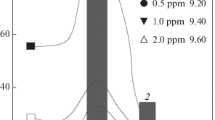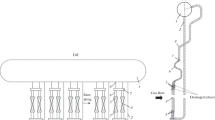Abstract—
The article considers the specific features related to operation of the power valve and orifice lines within turbine plant piping systems whose inlets receive water medium with saturation parameters (separated moisture or condensate). It is shown that transportation of working medium in these piping systems is accompanied by pressure drop, boiling, and formation of various two-phase flow patterns from bubble in the initial segment to dispersed-annual in the end segment. Under certain conditions, a slug flow pattern can occur, which behaves as a source of piping vibration. Practical experience has shown that the use of homogenizing inserts for suppressing vibration load in the heating steam condensate (HSC) discharge lines downstream of the moisture separator reheaters (MSRs) of nuclear power plant (NPP) turbines often leads to intensified local flow-accelerated corrosion and pipeline failures. The article considers examples illustrating failures of piping segments downstream of homogenizing inserts and presents statistical data on damageability of heating steam and separated moisture piping of NPP turbines. The steam–water flow patterns in the MSR HSC transportation line of an NPP turbine are determined. The results from hydrodynamic modeling of working medium flow under the conditions of an abrupt expansion at the outlet from the homogenizing insert channel are presented. It is shown that the location of zones characterized by the maximum wear of piping downstream of homogenizing inserts in the MSR HSC discharge lines is determined by the flow pattern and specific features of the working medium flow hydrodynamics. It has been established that droplet impingement erosion is the dominating mechanism causing destruction of stainless-steel piping segments downstream of the homogenizing inserts in the MSR HSC lines of NPP turbines. It is important to note that, if the pipeline is made of carbon or low alloy steel, its metal experiences a combined effect of droplet impingement erosion and flow-accelerated corrosion. The obtained study results can be used in elaborating measures aimed to prevent wear of piping components in the heating steam condensate and separated moisture discharge lines of NPP turbines.










Similar content being viewed by others
REFERENCES
B. Chexal, J. Horowitz, R. Jones, B. Dooley, C. Wood, M. Bouchacourt, F. Remy, F. Nordmann, and P. St. Paul, Flow-Accelerated Corrosion in Power Plants, Electric Power Research Institute Technical Report No. EPRI-TR106611-R1 (EPRI, 1996).
G. V. Tomarov, A. A. Shipkov, and D. V. Aflitonov, “Flow-accelerated corrosion wear of power-generating equipment: Investigations, prediction and prevention: 1. Flow-accelerated corrosion processes and regularities,” Therm. Eng. 65, 493–503 (2018). https://doi.org/10.1134/S0040601518090100
Z. Walker, Third Party Review of EPRI Recommendations for an Effective flow Accelerated Corrosion Program and Their Applicability to CANDU Reactors, SNC-Lavalin, Inc. Nuclear Document No. 147-33000-ASD-001, Rev. 1 (SNC-Lavalin, 2017).
Flow Accelerated Corrosion (FAC) of Carbon Steel and Low Alloy Steel Piping in Commercial Nuclear Power Plants, CODAP Topical Report No. NEA/CSNI/R(2014)6, JT03369511 (Nuclear Energy Agency, 2014).
G. V. Tomarov, “Erosion-corrosion of construction materials of saturated steam turbines,” Teploenergetika, No. 7, 38–43 (1989).
J. Malloy, M. Taylor, A. Fabricius, M. Graham, and D. Moelling, “Evaluating contributions of flow-accelerated corrosion and liquid droplet impingement to pipe thinning in HRSG evaporator tubes,” Power Plant Chem. 15, 264–274 (2013).
K. M. Hwang, H. Yun, and C. K. Lee, “A study of the cause investigation of the local pipe wall thinning in the downstream of an orifice through the UT data and numerical analysis,” in Proc. ASME-JSME-KSME 2011 Joint Fluids Engineering Conf. (AJK-Fluids 2011), Hamamatsu, Shizuoka, Japan, July 24–29, 2011 (ASME, New York, 2012).
Control Valve Flashing. https://www.emerson.com/ enus/automation/valves-actuators-regulators/control-valves/control-valve-flashing. Accessed November 21, 2018.
NUCIA, Report on SteamLeak in a Pipeline of Onagawa Nuclear Power Plant in 2007 [in Japanese]. http://www. nucia.jp/nucia/kn/KnTroubleView.do?troubleId=9373. Accessed November 21, 2018.
V. M. Zorin, Nuclear Power Plants: Study Aid (Mosk. Energ. Inst., Moscow, 2012) [in Russian].
M. A. Styrikovich, V. S. Polonskii, and G. V. Tsiklauri, Heat-and-Mass Exchange and Hydrodynamics in Two-Phase Flows of Nuclear Power Plants (Nauka, Moscow, 1982) [in Russian].
G. F. Hewitt and N. S. Hall-Taylor, Annular Two-Phase Flow (Pergamon, New York, 1970; Energiya, Moscow, 1974).
Author information
Authors and Affiliations
Corresponding author
Additional information
Translated by V. Filatov
Rights and permissions
About this article
Cite this article
Tomarov, G.V., Shipkov, A.A. & Komissarova, T.N. Factors and Mechanisms Causing Wear of Turbine Heating Steam Condensate Pipeline Components at a Nuclear Power Plant. Therm. Eng. 66, 662–671 (2019). https://doi.org/10.1134/S0040601519090052
Received:
Revised:
Accepted:
Published:
Issue Date:
DOI: https://doi.org/10.1134/S0040601519090052




